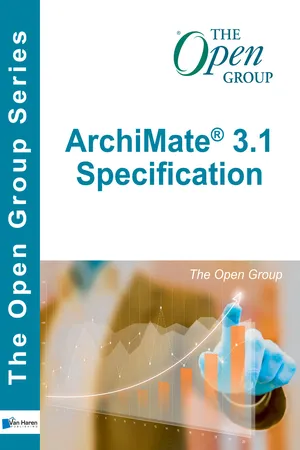
- English
- ePUB (mobile friendly)
- Available on iOS & Android
ArchiMate® 3.1 Specification
About This Book
The ArchiMate® Specification, a standard of The Open Group, defines an open and independent modeling language for Enterprise Architecture that is supported by different tool vendors and consulting firms. The ArchiMate language enables Enterprise Architects to describe, analyze, and visualize the relationships among business domains in an unambiguous way. This book is the official specification of the ArchiMate 3.1 modeling language from The Open Group. This edition of the standard includes a number of corrections, clarifications, and improvements to the previous edition, as well as several additions.The main changes between Version 3.0.1 and Version 3.1 of the ArchiMate Specification are listed below. In addition to these changes, various other minor improvements in definitions and other wording have been made: •Introduced a new strategy element: value stream•Added an optional directed notation for the association relationship •Improved the organization of the metamodel and associated figures •Further improved and formalized the derivation of relationships The intended audience is threefold: 1.Enterprise Architecture practitioners, such as architects (e.g., business, application, information, process, infrastructure, and, obviously, enterprise architects), senior and operational management, project leaders, and anyone committed to work within the reference framework defined by the Enterprise Architecture. 2.Those who intend to implement the ArchiMate language in a software tool; they will find a complete and detailed description of the language in this book. 3.• The academic community, on which we rely for amending and improving the language, based on state-of-the-art research results in the Enterprise Architecture field.
Frequently asked questions
Information
1 Introduction
1.1 Objective
1.2 Overview
1.3 Conformance
1.4 Normative References
1.5 Terminology
1.6 Future Directions
2 Definitions
2.1 ArchiMate Core Framework
Table of contents
- Cover
- Title
- Copyright
- Contents
- List of Figures
- List of Examples
- List of Tables
- Preface
- Trademarks
- Acknowledgements
- Referenced Documents
- 1 Introduction
- 2 Definitions
- 3 Language Structure
- 4 Generic Metamodel
- 5 Relationships
- 6 Motivation Elements
- 7 Strategy Elements
- 8 Business Layer
- 9 Application Layer
- 10 Technology Layer
- 11 Physical Elements
- 12 Relationships Between Core Layers
- 13 Implementation and Migration Elements
- 14 Stakeholders, Architecture Views, and Viewpoints
- 15 Language Customization Mechanisms
- A Summary of Language Notation
- B Relationships (Normative)
- C Example Viewpoints
- D Relationship to Other Standards, Specifications, and Guidance Documents
- E Changes from Version 2.1 to Version 3.1
- Acronyms
- Index